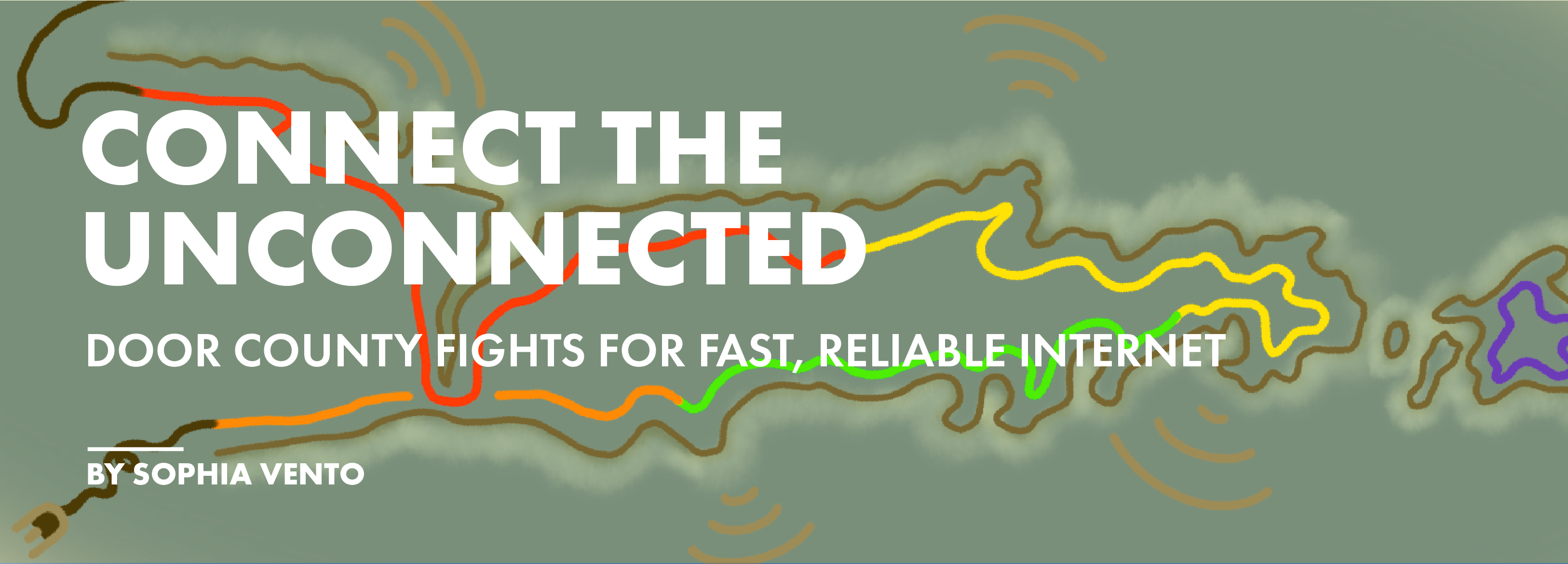For Kurt Kiefer, the optimal retirement from a decades-long career in information technology in Wisconsin public schools consisted of buying a condo in either downtown Madison or in its bustling Dudgeon-Monroe neighborhood.
However, his wife had other plans.
“And that was to move to Door County,” Kiefer says.
To a plot of land with zero available internet service providers.
“That’s immediately what lit my fire,” he says, reflecting back on the move. “It’s the 21st century utility that everyone needs that a whole bunch of people still don’t have.”
Kiefer, who served as an assistant state superintendent for Wisconsin’s Department of Public Instruction, and his wife later built a home in Baileys Harbor, a picturesque town of cottages and vacation rentals with thousands of acres of preserved wilderness along the northeastern shores of Lake Michigan. He would eventually spearhead a municipal-level committee with the primary goal of getting Baileys Harbor residents online.
“There’s a very real impact whether it’s for a kid, family or elder trying to connect with a doctor and avoid a 45-minute drive to Sturgeon Bay, or a business turning away patrons because they can’t process their cards,” Kiefer says. “You can’t live without the internet anymore.”

The fight to boost digital equity across the region is ongoing, however. Partnerships across sectors, including local governments, economic development corporations and nonprofit organizations, are propelling forward to connect all of Door County to high-speed internet.
“All 72 counties have locations, homes and businesses that don’t have either any service or don’t have good enough service to move into the future,” says Alyssa Kenney, the state broadband and digital equity director at the Wisconsin Public Service Commission.
In Wisconsin, nearly 246,000 locations have no broadband internet, while an additional 218,000 have unreliable or slow connections, according to a report from Gov. Tony Evers’ Task Force on Broadband Access.
In Door County, 808 locations are considered unserved, which means areas lacking internet with 25 megabits per second download and three megabits per second upload service — the bare minimum required to work remotely as a student or employee.
Meanwhile, 236 locations are underserved, meaning these locations lack 100 megabits per second download and 20 megabits per second upload speeds, according to a county map last updated in October. A speed of more than 100 megabits is best for multiple users and devices.
Just 204 locations have download speeds more than 100 megabits per second — the industry standard for high-speed internet through fiber-optic cables.
“By 2030, we’re going to be very close to universal service,” Kenney says. “I don’t think it will be like tap water, but it will be pretty close.”
“No one solves this problem on their own”
In 2019, prior to their official move to Baileys Harbor, Kiefer connected with the Door County Economic Development Corporation to collect data regarding broadband access. The group ultimately hired a third-party engineering firm to gauge internet connectivity across the region. They estimated it would cost $75 million to fund broadband infrastructure across the entire county.
In August 2020, Kiefer formed the Baileys Harbor Broadband Ad Hoc Committee. By March 2021, the group had selected an internet service provider partner and submitted grant applications to the state Public Service Commission. The project would cost an estimated $5.25 million — the town asked for a little under $2 million from the state, and it was funded that June.
“Baileys Harbor set the tone,” says Jessica Hatch, the county’s broadband coordinator hired in 2022, about the town’s broadband efforts and surveys.
Today, almost all of the municipalities in Door County are actively fighting to boost access to high-speed and reliable broadband internet through an approach rooted in action at municipal levels and collaboration at the county level. Just three communities do not have established committees dedicated to the issue, Hatch says.
“It requires people from 15 townships, four villages and one city to actually talk with each other about what they’re learning and doing,” Kiefer says.
Towns and villages are not competing with each other, they share grant applications and materials to lift each other up, according to Kiefer. The county even used federal relief money from the American Rescue Plan to create Hatch’s role — a centralized position many Wisconsin counties are not lucky enough to have, she says.
“Most counties don’t have a budget for someone like me,” Hatch says.
Right now, however, there is more money than ever coming into the state to boost broadband access.
The Broadband, Equity, Access and Deployment Program, funded by the 2021 Bipartisan Infrastructure Law, is a $42.45 billion initiative to help get all Americans online. Wisconsin is set to receive a little over $1 billion from this bill.
“There’s an emphasis on long-term sustainability,” Kenney says about the funding. “There’s not going to be a billion dollars for the state to connect everybody again. There’s a strong emphasis on doing it fast but also doing it right.”
“You don’t know what you don’t know”
Wisconsin has been at the forefront of efforts to boost broadband access for nearly a decade. What would become the broadband office formed in 2014. The governor’s task force was created in 2020 through an executive order.
“We were cutting edge in Wisconsin,” Kenney says.
In recent years, mapping unserved and underserved locations has kicked into high gear, as the state has challenged connectivity maps from the Federal Communications Commission. However, mapping at a local level — with accurate, representative data — is equally important.
“Once you have data, it’s hard to refute it,” Kiefer says.
This is no small task, though. Hatch likened the process of measuring internet service in Door County to “nailing Jell-O to a wall.” She added that local maps look “very different” from federal and even state maps.
“The ‘served’ definition is going to be based upon what providers are reporting as speeds,” Hatch says. “That’s not the reality of what people are getting.”
Door County partnered with the Public Service Commission to deploy an internet survey, which helps the county learn about internet service quality, information on average monthly billing and digital equity information. Hatch says this is the best decision the county could have ever made. She emphasized a huge response rate — 4,166 — on surveys, making up nearly half of respondents to the statewide survey.
“They’ve been so willing to collaborate,” Kiefer says about Door County residents.
For Hatch, it remains important to prove to the state that Door County needs fast, reliable internet as the state prepares to divvy up federal funding for broadband expansion.
“We have had the time to have the conversations,” Hatch says. “I just hope we have enough data and narrative to show the want and need.”
In Baileys Harbor, specifically, Kiefer and broadband advocates continue to chug along.
“Our goal continues to be to have every one of the roughly 1,500 address locations accessible to fiber by the end of next year,” Kiefer says. “It can be done. It’s not impossible. It’s not easy.”
